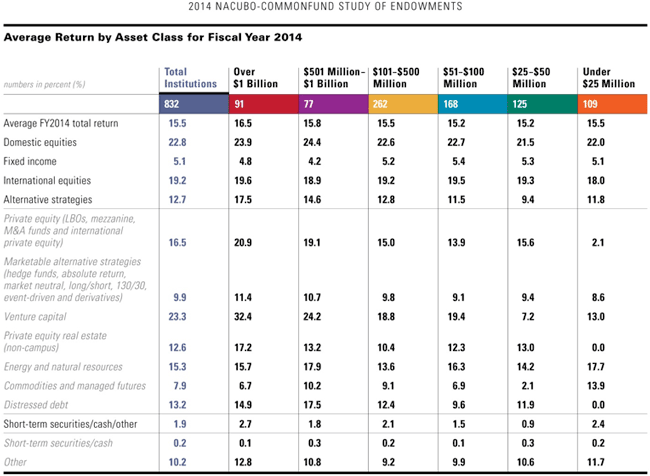Is The Endowment Investment Model Broken US News
Post on: 5 Июнь, 2015 No Comment

Yale’s performance still says no.
For years advisers, brokerage houses, banks, and investing magazines have touted the traditional investment model of a simple mix of stocks and bonds. or mutual funds. Proponents of a simple investing model may have reason to rejoice according to recent data compiled by the National Association of College and University Business Officers. The latest report for fiscal year 2011 shows that 90 percent of the college endowments polled have underperformed a traditional portfolio of 60 percent equities and 40 percent fixed income over one-, three-, and five-year periods.
Of course, the thorn in their side has been the outperformance of a few large college endowment funds. Some, like Yale, posted 10-year annualized returns of 10.1 percent and 20 year annualized returns of 14.2 percent as of last year.
Are Simple Stock and Bond Portfolios Better?
There are two conclusions one can draw from this data and it all boils down to how you think as an investor. Are you a “status quo” investor or an “entrepreneurial” investor? A “status quo” investor is happy with being average and would conclude that if 90 percent of college endowments underperformed the common 60/40 stock/bond split, then why not just keep it simple by investing in balanced mutual funds? An “entrepreneurial” investor would ask, “What did the other 10 percent of endowments do to beat the average portfolio?”
Yale’s Secret Sauce(s)
First, a word of caution, Yale’s successful approach isn’t for everyone because it requires a bit more capital than just buying commonly available mutual funds. If you’ve saved at least $250,000 in investable funds you have enough money to achieve a Yale-like diversification (high investment minimums are required for access to more esoteric investment products). It also takes more work. Actually following the Yale strategy (which climbed 4.5 percent in 2008 while the market fell close to 40 percent) may prove to be more difficult for even experienced investors, in part because those investment vehicles (such as real estate. private equity, or natural resources) can also lack liquidity, which may cause some investors feeling like they are in less contro l when in fact illiquidity is an important component, especially during market free falls. At any rate, diversity is key, and part of Yale’s success during the crisis was its limited exposure to equities in favor of those less-liquid assets. There’s little debate that the endowment model of investing requires a bit more sophistication and unique access than the traditional and common stock/bond portfolio. Yale’s current allocation (as of June 2011), as an example, is comprised of:

If you don’t have enough saved for retirement or you’re okay with the status quo then you’ll have to settle for the common stock/bond approach. However, if you’re like me and you desire an above average future (and retirement) spend some time to understand how Yale has outperformed its peers and possibly work with an adviser that has experience with the endowment investment approach.
Robert Russell is the author of Retirement Held Hostage. CEO & CIO of the Ohio-based Russell & Company, a private wealth management firm specializing in helping affluent individuals ages 45 and up create and preserve their wealth. He co-hosts a radio show, authors The Rob Report blog, and is a frequent contributor to The Wall Street Journal, SmartMoney, & FOX Business.














